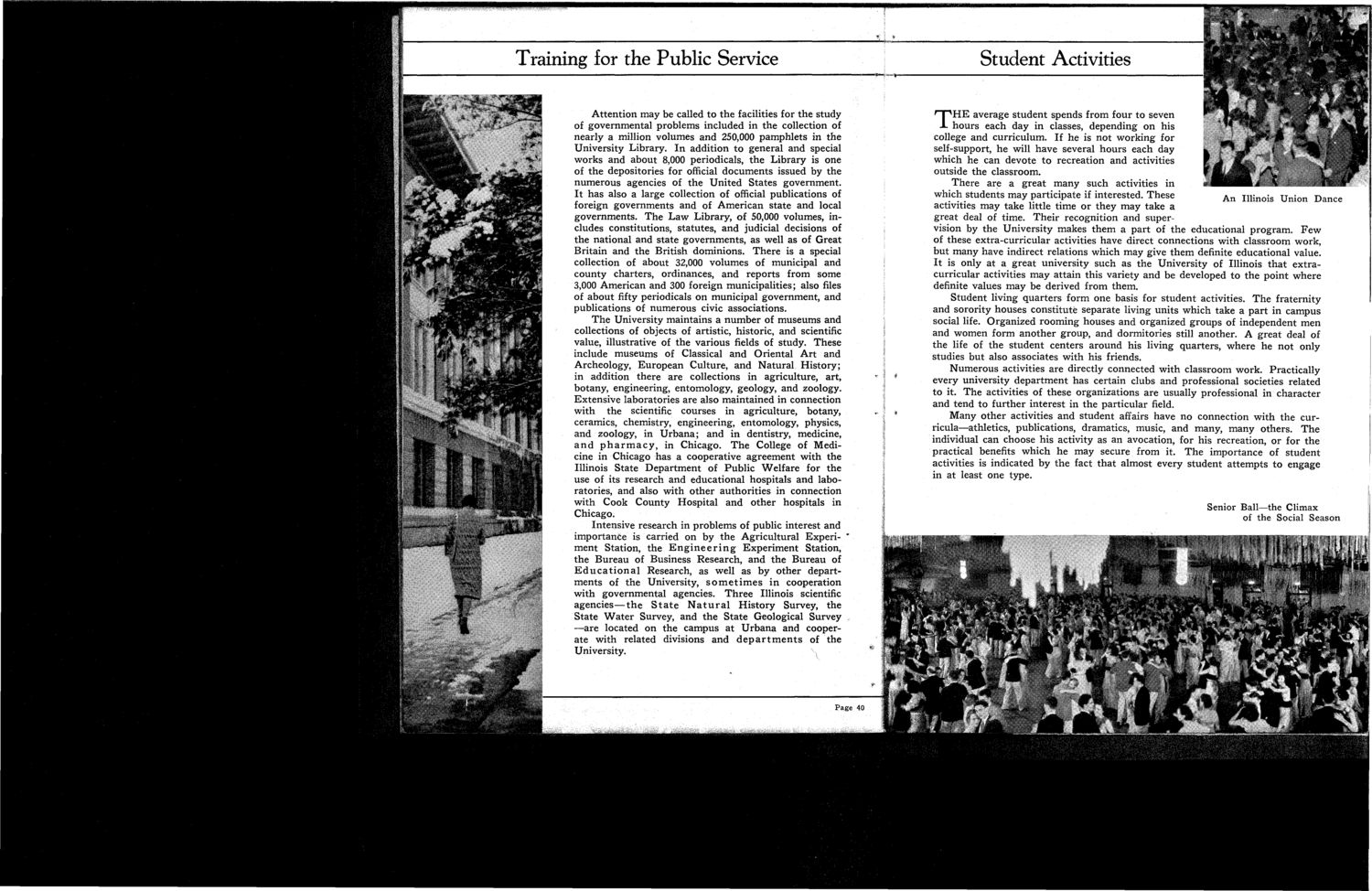| |
| |
Caption: Booklet - Your First Year the University (1935)
This is a reduced-resolution page image for fast online browsing.

EXTRACTED TEXT FROM PAGE:
Training for the Public Service Attention may be called to the facilities for the study of governmental problems included in the collection of nearly a million volumes and 250,000 pamphlets in the University Library. In addition to general and special works and about 8,000 periodicals, the Library is one of the depositories for official documents issued by the numerous agencies of the United States government. It has also a large collection of official publications of foreign governments and of American state and local governments. The Law Library, of 50,000 volumes, includes constitutions, statutes, and judicial decisions of the national and state governments, as well as of Great Britain and the British dominions. There is a special collection of about 32,000 volumes of municipal and county charters, ordinances, and reports from some 3,000 American and 300 foreign municipalities; also files of about fifty periodicals on municipal government, and publications of numerous civic associations. The University maintains a number of museums and collections of objects of artistic, historic, and scientific value, illustrative of the various fields of study. These include museums of Classical and Oriental Art and Archeology, European Culture, and Natural History; in addition there are collections in agriculture, art, botany, engineering, entomology, geology, and zoology. Extensive laboratories are also maintained in connection with the scientific courses in agriculture, botany, ceramics, chemistry, engineering, entomology, physics, and zoology, in Urbana; and in dentistry, medicine, a n d p h a r m a c y , in Chicago. T h e College of Medicine in Chicago has a cooperative agreement with the Illinois State Department of Public Welfare for the use of its research and educational hospitals and laboratories, and also with other authorities in connection with Cook County Hospital and other hospitals in Chicago. Intensive research in problems of public interest and importance is carried on by the Agricultural Experiment Station, the E n g i n e e r i n g Experiment Station, the Bureau of Business Research, and the Bureau of E d u c a t i o n a l Research, as well as by other departments of the University, s o m e t i m e s in cooperation with governmental agencies. Three Illinois scientific agencies—the S t a t e N a t u r a l History Survey, the State W a t e r Survey, and the State Geological Survey —are located on the campus at Urbana and cooperate with related divisions and d e p a r t m e n t s of the University. \ • Student Activities H E average student spends from four to seven hours each day in classes, depending on his college and curriculum. If he is not working for self-support, he will have several hours each day which he can devote to recreation and activities outside the classroom. There are a great many such activities in which students may participate if interested. These Illinois Union Dance activities may take little time or they may take a great deal of time. Their recognition and supervision by the University makes them a part of the educational program. Few of these extra-curricular activities have direct connections with classroom work, but many have indirect relations which may give them definite educational value. It is only at a great university such as the University of Illinois that extracurricular activities may attain this variety and be developed to the point where definite values may be derived from them. Student living quarters form one basis for student activities. The fraternity and sorority houses constitute separate living units which take a part in campus social life. Organized rooming houses and organized groups of independent men and women form another group, and dormitories still another. A great deal of the life of the student centers around his living quarters, where he not only studies but also associates with his friends. Numerous activities are directly connected with classroom work. Practically every university department has certain clubs and professional societies related to it. The activities of these organizations are usually professional in character and tend to further interest in the particular field. Many other activities and student affairs have no connection with the curricula—athletics, publications, dramatics, music, and many, many others. The individual can choose his activity as an avocation, for his recreation, or for the practical benefits which he may secure from it. T h e importance of student activities is indicated by the fact that almost every student attempts to engage in at least one type. Senior Ball—the Climax of the Social Season T Page 40 >'*!&* mtff'fW[[i^^l^^^KWM.
| |